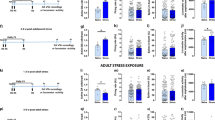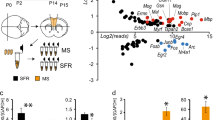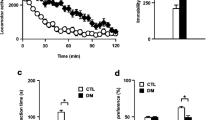Abstract
Stress derived from an adverse environment during brain development could contribute to psychiatric disorders. To study the influence of stress occurring at birth on behavior development in human, we performed an intraperitoneal injection (i.p.) of valproic acid (VPA; 200 mg/kg), a histone deacetylation inhibitor (HDACi), into male rat pups at the age of postnatal day 7 (P7) that is equivalent to an infant at 36–40 weeks gestation. Our results showed that neuronal differentiation genes, doublecortin (DCX) and NeuroD1, were downregulated in the hippocampus at 24 h post VPA injection. In addition, the cell proliferation was increased in the dentate gyrus and amygdala of rats receiving VPA injection. DCX+ and NeuN+ cell population was decreased in the dentate gyrus at 24 h post VPA injection. Moreover, microglial morphological changes in the hippocampus and amygdala were rapidly induced at 24 h after VPA injection. Through a series of behavior tests, we found that rats receiving VPA injection displayed depressive and anxiety-like behaviors at the late postnatal ages, and had impaired social interaction at 8 weeks old. In summary, a single postnatal administration of VPA not only disrupted neural cell differentiation program but also induced anxious, depressive, and impaired social behaviors. Our findings also shed light on early life stress to infants as a significant risk factor with regard to developing emotional disorders in youth, and that these effects may continue into adulthood, possibly due to altered gene expression and neuron-glia interaction occurring in the hippocampus and amygdala at an early age.








Similar content being viewed by others
Abbreviations
- ASDs:
-
Autism spectrum disorders
- BrdU:
-
Bromodeoxyuridine
- CNS:
-
Central nervous system
- DAB:
-
3,3′Diaminobenzidine tetrahydrochloride
- DCX:
-
Doublecortin
- EPM:
-
Elevated plus maze
- FST:
-
Forced swimming test
- GFAP:
-
Glial fibrillary acidic protein
- HDAC:
-
Histone deacetylation
- FST:
-
Forced swimming test
- OFT:
-
Open field test
- P:
-
Postnatal day
- QPCR:
-
Quantitative real-time polymerase chain reaction
- SD:
-
Sprague-Dawley
- TRHR:
-
Thyrotropin-releasing hormone receptor
- VPA:
-
Valproic acid
References
Loman MM, Gunnar MR (2010) Early experience and the development of stress reactivity and regulation in children. Neurosci Biobehav Rev 34(6):867–876
Lucassen PJ, Naninck EF, van Goudoever JB, Fitzsimons C, Joels M, Korosi A (2013) Perinatal programming of adult hippocampal structure and function; emerging roles of stress, nutrition and epigenetics. Trends Neurosci 36(11):621–631
Heim C, Nemeroff CB (2001) The role of childhood trauma in the neurobiology of mood and anxiety disorders: preclinical and clinical studies. Biol Psychiatry 49(12):1023–1039
Huot RL, Plotsky PM, Lenox RH, McNamara RK (2002) Neonatal maternal separation reduces hippocampal mossy fiber density in adult Long Evans rats. Brain Res 950(1-2):52–63
Fabricius K, Wortwein G, Pakkenberg B (2008) The impact of maternal separation on adult mouse behaviour and on the total neuron number in the mouse hippocampus. Brain Struct Funct 212(5):403–416
Leventopoulos M, Ruedi-Bettschen D, Knuesel I, Feldon J, Pryce CR, Opacka-Juffry J (2007) Long-term effects of early life deprivation on brain glia in Fischer rats. Brain Res 1142:119–126
Oomen CA, Soeters H, Audureau N, Vermunt L, van Hasselt FN, Manders EM, Joels M, Lucassen PJ et al (2010) Severe early life stress hampers spatial learning and neurogenesis, but improves hippocampal synaptic plasticity and emotional learning under high-stress conditions in adulthood. J Neurosci 30(19):6635–6645
Bailey A, Luthert P, Dean A, Harding B, Janota I, Montgomery M, Rutter M, Lantos P (1998) A clinicopathological study of autism. Brain 121(Pt 5):889–905
Schumann CM, Amaral DG (2006) Stereological analysis of amygdala neuron number in autism. J Neurosci 26(29):7674–7679
Wang CC, Lin HC, Chan YH, Gean PW, Yang YK, Chen PS (2013) 5-HT1A-receptor agonist modified amygdala activity and amygdala-associated social behavior in a valproate-induced rat autism model. Int J Neuropsychopharmacol 16(9):2027–2039
Phiel CJ, Zhang F, Huang EY, Guenther MG, Lazar MA, Klein PS (2001) Histone deacetylase is a direct target of valproic acid, a potent anticonvulsant, mood stabilizer, and teratogen. J Biol Chem 276(39):36734–36741
Moore SJ, Turnpenny P, Quinn A, Glover S, Lloyd DJ, Montgomery T, Dean JC (2000) A clinical study of 57 children with fetal anticonvulsant syndromes. J Med Genet 37(7):489–497
Christensen J, Gronborg TK, Sorensen MJ, Schendel D, Parner ET, Pedersen LH, Vestergaard M (2013) Prenatal valproate exposure and risk of autism spectrum disorders and childhood autism. JAMA 309(16):1696–1703
Genton P, Semah F, Trinka E (2006) Valproic acid in epilepsy: pregnancy-related issues. Drug Saf 29(1):1–21
Rasalam AD, Hailey H, Williams JH, Moore SJ, Turnpenny PD, Lloyd DJ, Dean JC (2005) Characteristics of fetal anticonvulsant syndrome associated autistic disorder. Dev Med Child Neurol 47(8):551–555
Markram K, Rinaldi T, La Mendola D, Sandi C, Markram H (2008) Abnormal fear conditioning and amygdala processing in an animal model of autism. Neuropsychopharmacology 33(4):901–912
Schneider T, Przewlocki R (2005) Behavioral alterations in rats prenatally exposed to valproic acid: animal model of autism. Neuropsychopharmacology 30(1):80–89
Wagner GC, Reuhl KR, Cheh M, McRae P, Halladay AK (2006) A new neurobehavioral model of autism in mice: pre- and postnatal exposure to sodium valproate. J Autism Dev Disord 36(6):779–793
Edalatmanesh MA, Nikfarjam H, Vafaee F, Moghadas M (2013) Increased hippocampal cell density and enhanced spatial memory in the valproic acid rat model of autism. Brain Res 1526:15–25
Go HS, Kim KC, Choi CS, Jeon SJ, Kwon KJ, Han SH, Lee J, Cheong JH et al (2012) Prenatal exposure to valproic acid increases the neural progenitor cell pool and induces macrocephaly in rat brain via a mechanism involving the GSK-3beta/beta-catenin pathway. Neuropharmacology 63(6):1028–1041
Oguchi-Katayama A, Monma A, Sekino Y, Moriguchi T, Sato K (2013) Comparative gene expression analysis of the amygdala in autistic rat models produced by pre- and post-natal exposures to valproic acid. J Toxicol Sci 38(3):391–402
Yochum CL, Dowling P, Reuhl KR, Wagner GC, Ming X (2008) VPA-induced apoptosis and behavioral deficits in neonatal mice. Brain Res 1203:126–132
Chomiak T, Karnik V, Block E, Hu B (2010) Altering the trajectory of early postnatal cortical development can lead to structural and behavioural features of autism. BMC Neurosci 11:102
Reynolds S, Millette A, Devine DP (2012) Sensory and motor characterization in the postnatal valproate rat model of autism. Dev Neurosci 34(2-3):258–267
Williams G, King J, Cunningham M, Stephan M, Kerr B, Hersh JH (2001) Fetal valproate syndrome and autism: additional evidence of an association. Dev Med Child Neurol 43(3):202–206
Semple BD, Blomgren K, Gimlin K, Ferriero DM, Noble-Haeusslein LJ (2013) Brain development in rodents and humans: identifying benchmarks of maturation and vulnerability to injury across species. Prog Neurobiol 106–107:1–16
Chen YW, Lin HC, Ng MC, Hsiao YH, Wang CC, Gean PW, Chen PS (2014) Activation of mGluR2/3 underlies the effects of N-acetylcystein on amygdala-associated autism-like phenotypes in a valproate-induced rat model of autism. Front Behav Neurosci 8:219
Pesarico AP, Sampaio TB, Stangherlin EC, Mantovani AC, Zeni G, Nogueira CW (2014) The antidepressant-like effect of 7-fluoro-1,3-diphenylisoquinoline-1-amine in the mouse forced swimming test is mediated by serotonergic and dopaminergic systems. Prog Neuropsychopharmacol Biol Psychiatry 54: 179–186
Gao J, Li M (2014) Differential effects of intermittent versus continuous haloperidol treatment throughout adolescence on haloperidol sensitization and social behavior in adulthood. Prog Neuropsychopharmacol Biol Psychiatry 54C:67–75
Lin HC, Gean PW, Wang CC, Chan YH, Chen PS (2013) The amygdala excitatory/inhibitory balance in a valproate-induced rat autism model. PLoS One 8(1):e55248
Dufour-Rainfray D, Vourc’h P, Le Guisquet AM, Garreau L, Ternant D, Bodard S, Jaumain E, Gulhan Z et al (2010) Behavior and serotonergic disorders in rats exposed prenatally to valproate: a model for autism. Neurosci Lett 470(1):55–59
Zeng H, Schimpf BA, Rohde AD, Pavlova MN, Gragerov A, Bergmann JE (2007) Thyrotropin-releasing hormone receptor 1-deficient mice display increased depression and anxiety-like behavior. Mol Endocrinol 21(11):2795–2804
Torner L, Toschi N, Pohlinger A, Landgraf R, Neumann ID (2001) Anxiolytic and anti-stress effects of brain prolactin: improved efficacy of antisense targeting of the prolactin receptor by molecular modeling. J Neurosci 21(9):3207–3214
Torner L, Neumann ID (2002) The brain prolactin system: involvement in stress response adaptations in lactation. Stress 5(4):249–257
Lajud N, Gonzalez-Zapien R, Roque A, Tinajero E, Valdez JJ, Clapp C, Torner L (2013) Prolactin administration during early postnatal life decreases hippocampal and olfactory bulb neurogenesis and results in depressive-like behavior in adulthood. Horm Behav 64(5):781–789
Morgane PJ, Mokler DJ, Galler JR (2002) Effects of prenatal protein malnutrition on the hippocampal formation. Neurosci Biobehav Rev 26 (4):471-483
MacDonald JL, Roskams AJ (2008) Histone deacetylases 1 and 2 are expressed at distinct stages of neuro-glial development. Dev Dyn 237(8):2256–2267
Akhtar MW, Raingo J, Nelson ED, Montgomery RL, Olson EN, Kavalali ET, Monteggia LM (2009) Histone deacetylases 1 and 2 form a developmental switch that controls excitatory synapse maturation and function. J Neurosci 29(25):8288–8297
Hao Y, Creson T, Zhang L, Li P, Du F, Yuan P, Gould TD, Manji HK et al (2004) Mood stabilizer valproate promotes ERK pathway-dependent cortical neuronal growth and neurogenesis. J Neurosci 24(29):6590–6599
Hsieh J, Nakashima K, Kuwabara T, Mejia E, Gage FH (2004) Histone deacetylase inhibition-mediated neuronal differentiation of multipotent adult neural progenitor cells. Proc Natl Acad Sci U S A 101(47):16659–16664
Yu IT, Park JY, Kim SH, Lee JS, Kim YS, Son H (2009) Valproic acid promotes neuronal differentiation by induction of proneural factors in association with H4 acetylation. Neuropharmacology 56(2):473–480
Kettenmann H, Kirchhoff F, Verkhratsky A (2013) Microglia: new roles for the synaptic stripper. Neuron 77(1):10–18
Hayashi Y, Nakanishi H (2013) Synaptic plasticity and synaptic reorganization regulated by microglia. FS 33(5-6):211–216
Wohleb ES, Hanke ML, Corona AW, Powell ND, Stiner LM, Bailey MT, Nelson RJ, Godbout JP et al (2011) beta-Adrenergic receptor antagonism prevents anxiety-like behavior and microglial reactivity induced by repeated social defeat. J Neurosci 31(17):6277–6288
Tynan RJ, Naicker S, Hinwood M, Nalivaiko E, Buller KM, Pow DV, Day TA, Walker FR (2010) Chronic stress alters the density and morphology of microglia in a subset of stress-responsive brain regions. Brain Behav Immun 24(7):1058–1068
Delpech JC, Madore C, Nadjar A, Joffre C, Wohleb ES, Laye S (2015) Microglia in neuronal plasticity: influence of stress. Neuropharmacology 96(Pt A):19–28
Millhouse OE, De Olmos J (1983) Neuronal configurations in lateral and basolateral amygdala. Neuroscience 10(4):1269–1300
Smith Y, Pare D (1994) Intra-amygdaloid projections of the lateral nucleus in the cat: PHA-L anterograde labeling combined with postembedding GABA and glutamate immunocytochemistry. J Comp Neurol 342(2):232–248
McDonald AJ, Augustine JR (1993) Localization of GABA-like immunoreactivity in the monkey amygdala. Neuroscience 52(2):281–294
Davis M, Whalen PJ (2001) The amygdala: vigilance and emotion. Mol Psychiatry 6(1):13–34
Kemper TL, Bauman M (1998) Neuropathology of infantile autism. J Neuropathol Exp Neurol 57(7):645–652
Sparks BF, Friedman SD, Shaw DW, Aylward EH, Echelard D, Artru AA, Maravilla KR, Giedd JN et al (2002) Brain structural abnormalities in young children with autism spectrum disorder. Neurology 59(2):184–192
Aylward EH, Minshew NJ, Goldstein G, Honeycutt NA, Augustine AM, Yates KO, Barta PE, Pearlson GD (1999) MRI volumes of amygdala and hippocampus in non-mentally retarded autistic adolescents and adults. Neurology 53(9):2145–2150
Nillni EA, Sevarino KA (1999) The biology of pro-thyrotropin-releasing hormone-derived peptides. Endocr Rev 20(5):599–648
Swaab DF (2004) Neuropeptides in hypothalamic neuronal disorders. Int Rev Cytol 240:305–375
Larsen CM, Grattan DR (2012) Prolactin, neurogenesis, and maternal behaviors. Brain Behav Immun 26(2):201–209
Murgatroyd CA, Nephew BC (2013) Effects of early life social stress on maternal behavior and neuroendocrinology. Psychoneuroendocrinology 38(2):219–228
Faron-Gorecka A, Kusmider M, Kolasa M, Zurawek D, Gruca P, Papp M, Szafran K, Solich J et al (2014) Prolactin and its receptors in the chronic mild stress rat model of depression. Brain Res 1555:48–59
Acknowledgments
This project was supported by the Ministry of Science and Technology in Taiwan (NSC 99-2321-B-006 -002 and MOST 103-2321-B-006 -010) and NCKU Aim for the Top University Project support by Ministry of Education in Taiwan (D104-38A04). The authors thank Ting-Xuan Chang and Meng-Hua Song for technical assistance.
Author information
Authors and Affiliations
Corresponding author
Ethics declarations
Conflict of Interest
All authors declare that there are no conflicts of interest.
Additional information
Chien-Wen Cheng and Wei-Hua Wang have equal contribution.
Rights and permissions
About this article
Cite this article
Wang, CY., Cheng, CW., Wang, WH. et al. Postnatal Stress Induced by Injection with Valproate Leads to Developing Emotional Disorders Along with Molecular and Cellular Changes in the Hippocampus and Amygdala. Mol Neurobiol 53, 6774–6785 (2016). https://doi.org/10.1007/s12035-015-9600-9
Received:
Accepted:
Published:
Issue Date:
DOI: https://doi.org/10.1007/s12035-015-9600-9




